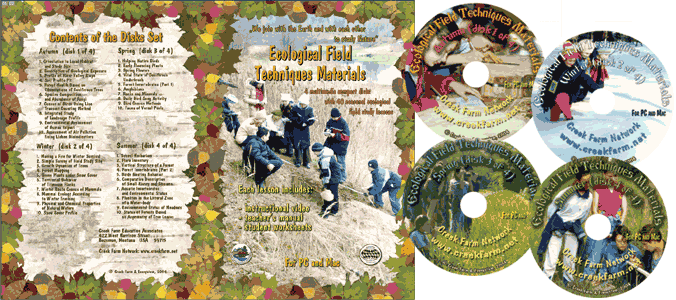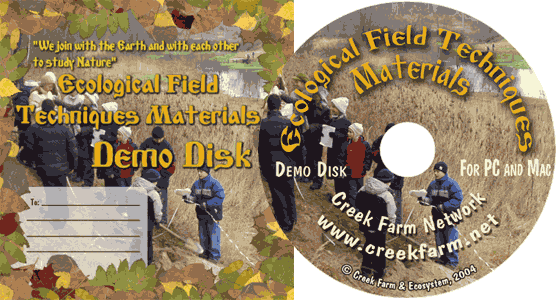|
| Our Field Ecology Center published more than
180 methodical materials for nature studies. Some of them are in English: |
|
|
|
Let's Help Birds!
© Alexsander S. Bogolyubov,
Russia, 2002
© Michael J. Brody, USA,
2003
 This manual describes two
practical nature conservation projects devoted to attracting birds: feeding winter birds,
and making and hanging artificial nesting places. Included are the design of simple bird
feeders and composition of birdseed, the procedure for making artificial nesting places as
well as general rules for hanging birdhouses. This manual describes two
practical nature conservation projects devoted to attracting birds: feeding winter birds,
and making and hanging artificial nesting places. Included are the design of simple bird
feeders and composition of birdseed, the procedure for making artificial nesting places as
well as general rules for hanging birdhouses.
This field study has instructional video
featuring real students conducting the ecological field techniques in nature. Each video
illustrates the primary instructional outcomes and the major steps in accomplishing the
task including reporting the results.
Introduction
This activity begins the series of nature lessons for students in spring. As it is with
the other seasonal cycles of the given lesson series, the first lesson of the season is
not devoted to conducting research work, but is rather a practical lesson. The
lesson consists of two practical approaches to attracting birds into the vicinity
of the school or field studies center. It includes feeding birds, as well as making
and hanging artificial nesting places for birds.
It is recommended to begin these projects as early as possible. Theoretically, birds
should be fed during the whole winter, whereas artificial nesting places should be hung up
prior to the beginning of the nesting season of wintering insectivore birds. These birds
are mainly tits, and they start to breed quite early. Titmice start to pair and to look
for a place to make a nest in March. Correspondingly, birdhouses should be made and hung
up by that time.
The organization of the studentsТ work making and hanging feeders and artificial
nesting places depends entirely on local conditions, size of the students' group and age
of students, availability of feed time, tools and building materials. Time and amount of
performance of the task are under the jurisdiction of the teacher whose students
participate in this study. Perhaps some will find it more convenient to perform the work
in fall or to combine this work with lessons on handicraft at school in winter, when
students are free from any other practical studies in nature.
We will provide only general rules for the organization of practical work and technical
details of its performance in the present manual.
Bird feeding organization
Introduction
Most birds leave the temperate climatic zone and fly away in the fall through the
winter, but many settled and migrant birds stay the winter. At that time, birds are
subjected to various climatic effects, which impede getting food. Snowstorms and
heavy snowfalls, glaze (frazil), covering branches and trunks of trees with a thin crust
of ice, as well as changeable weather and prolonged hard frosts always cause mass death of
small birds due to lack of feed. Timely feeding will allow conservation of almost all the
wintering birds.
It would be wrong to think that feeding birds is aimed at feeding them to their fill in
order to spare them from catching insects in nature. The fact is that birds often do not
have time to eat to their fill by catching natural food, which is not always found at once
in a short winter day in order to survive the night until the morning. If birdТs stomach
does not receive a minimum food day after day, then the bird will grow weak and die due to
exhaustion.
The total vital functions of wintering birds increase significantly due to feeding.
When birds feed up at the feeder, they start to search actively for feed on trees in the
vicinity of the feeder.
In addition, feeding birds can detain them for nesting near the feeding place.
Observations show that old birds will always fly back to their last yearТs breeding
places, whereas young birds, nesting for the first time, can build nests in a new place.
Provision for feeding wintering birds is a useful activity for schools and students. If
there is a well-designed and fixed feeder near the school in such a place, which is ...
This was only the first page from the manual and its full version you can see in the
Ecological Field Studies Techniques Video 4CD Set:
It is possible to purchase the complete set of 40 seasonal Ecological Field
Studies Techniques Video (in mpg format) in an attractive 4 compact disk set.
These compact disks are compatible with Mac and PC computers.
The videos are suitable for individual student or whole class instruction. To purchase the complete 4CD set
write to ecosystema1994@yandex.ru in a free form.

Ecological Field Studies Demo Disk:
We also have a free and interesting demonstration disk that explains our ecological field studies approach.
The demo disk has short excerpts from all the seasonal field study videos as well as sample text from all the teacher manuals.
The disk has an entertaining automatic walk through which describes the field study approach and explains how field studies meet education standards.
You can also download the Demo Disc from ecosystema.ru/eng/eftm/CD_Demo.iso.
This is a virtual hybrid (for PC and Mac computers) CD-ROM image (one 563 Mb file "CD_Demo.iso").
You can write this image to the CD and use it in your computer in ordinary way.
You also can use emulator software of virtual CD-ROM drive to play the disk directly from your hard disk.

|







